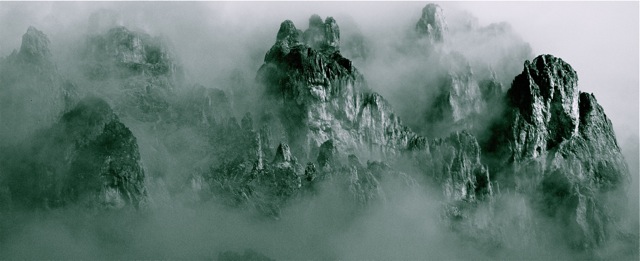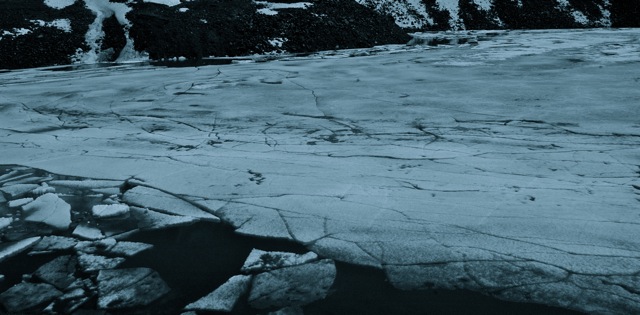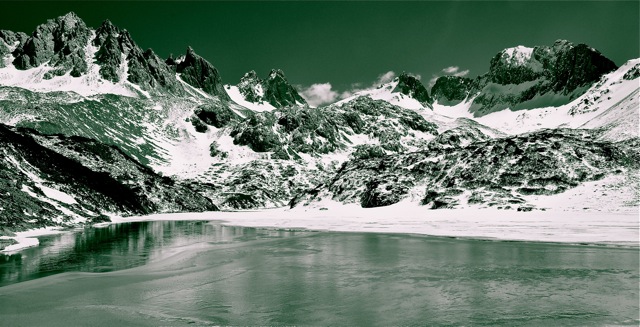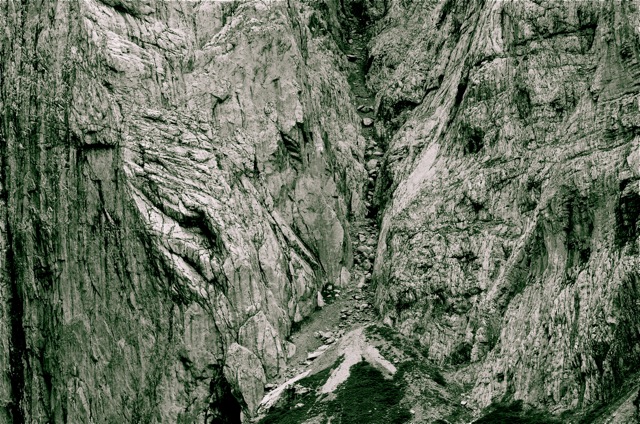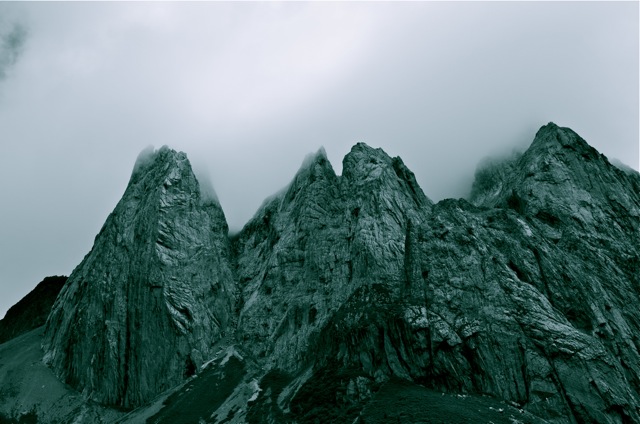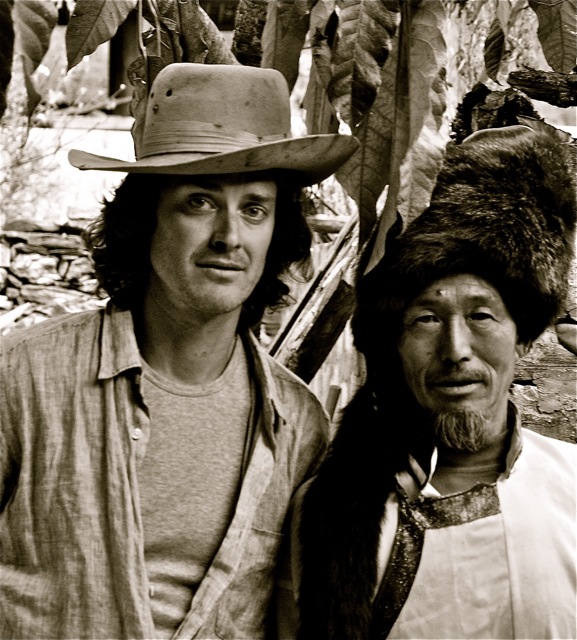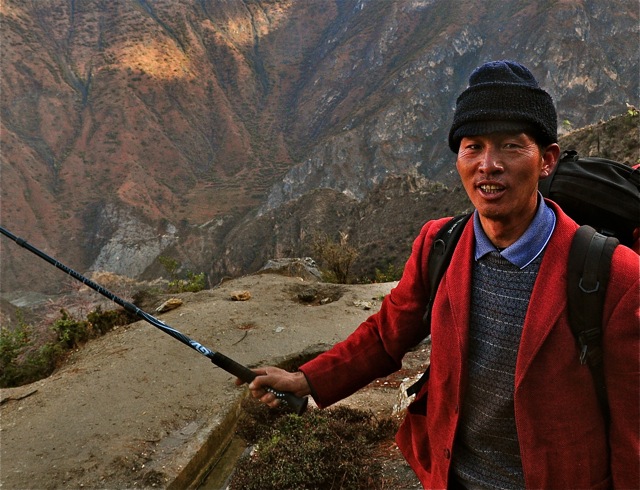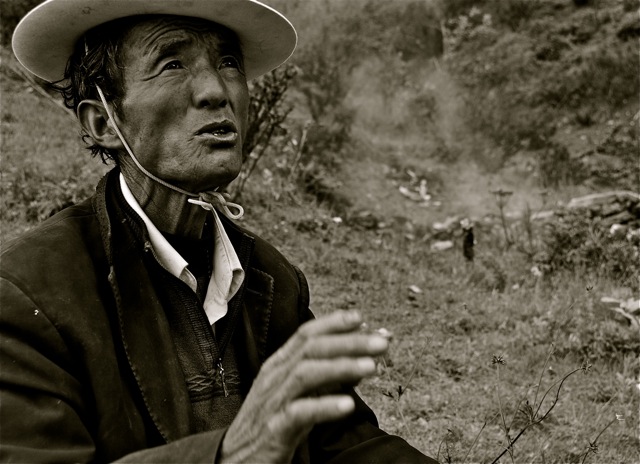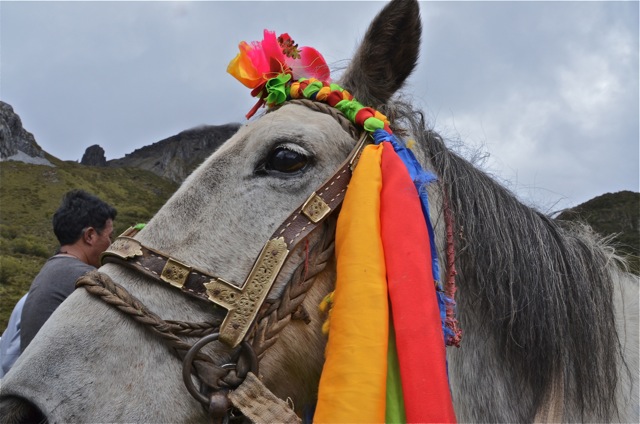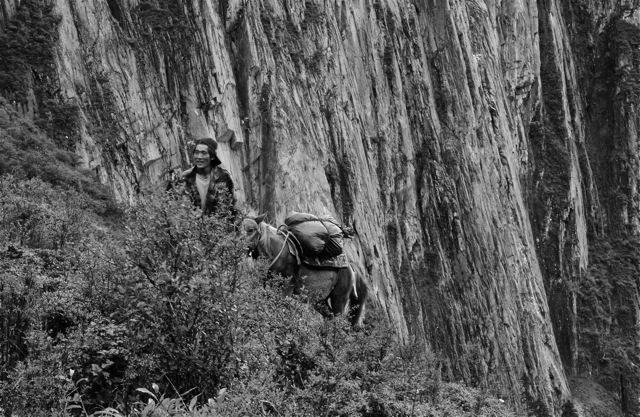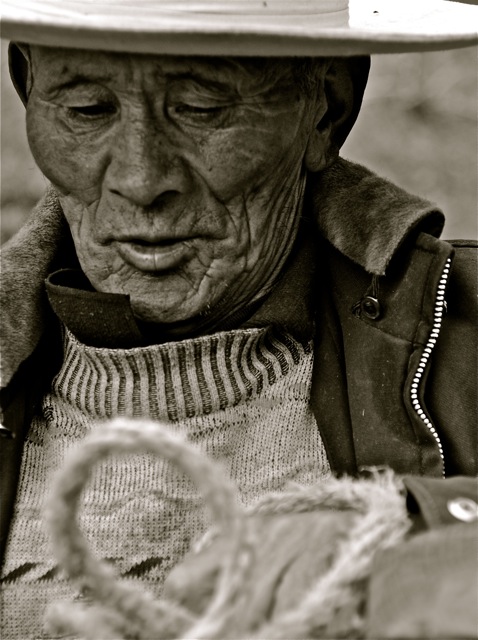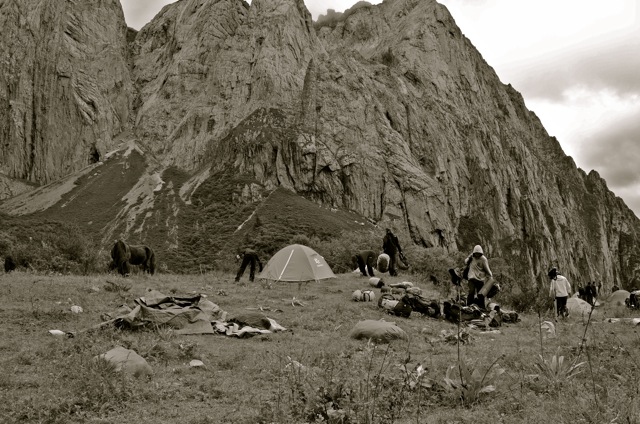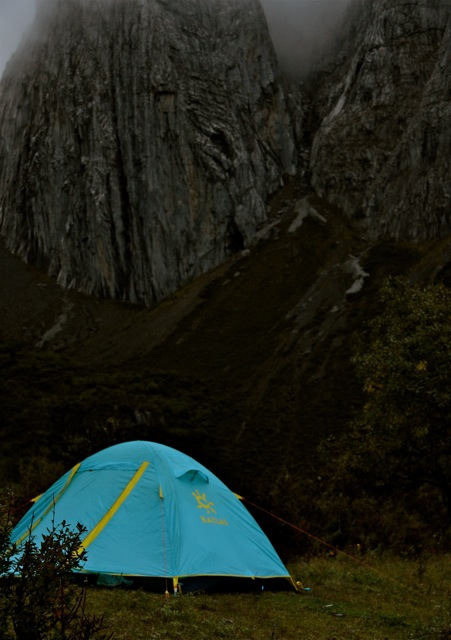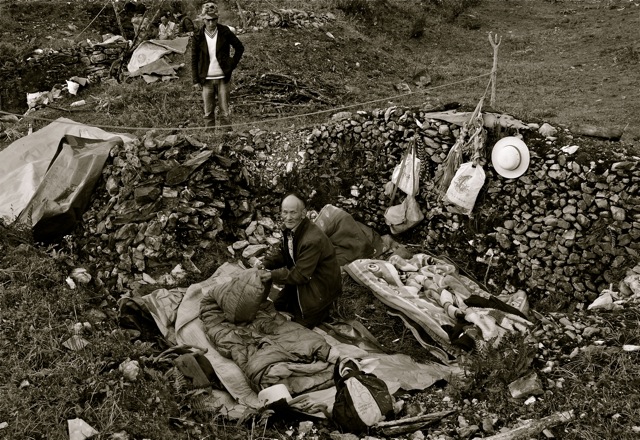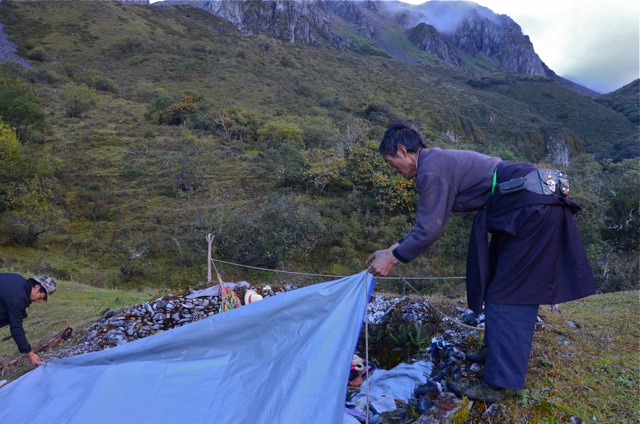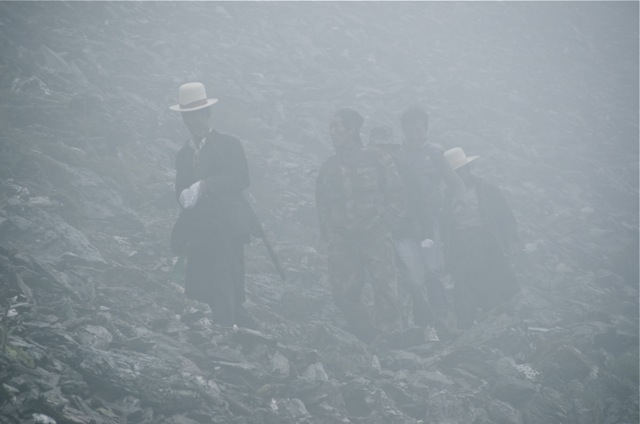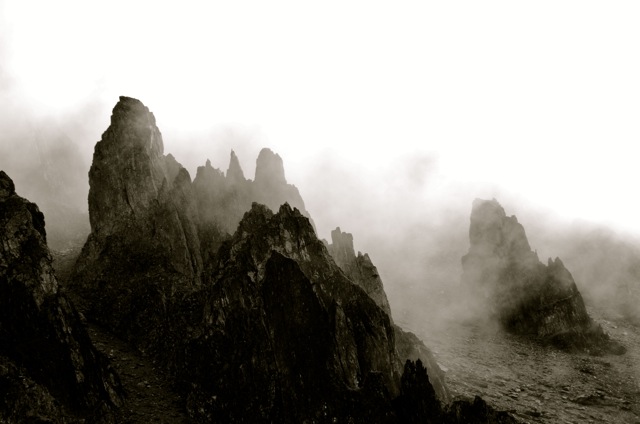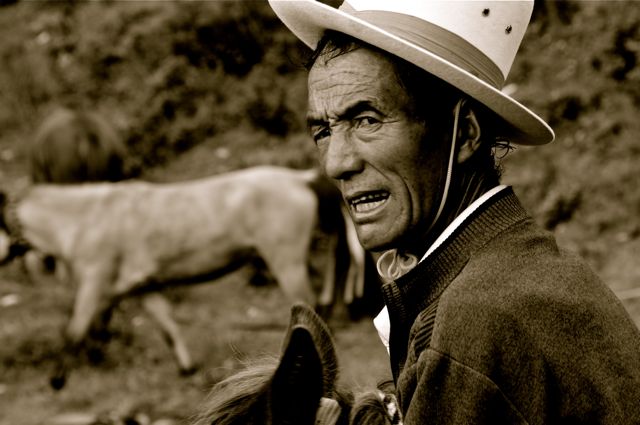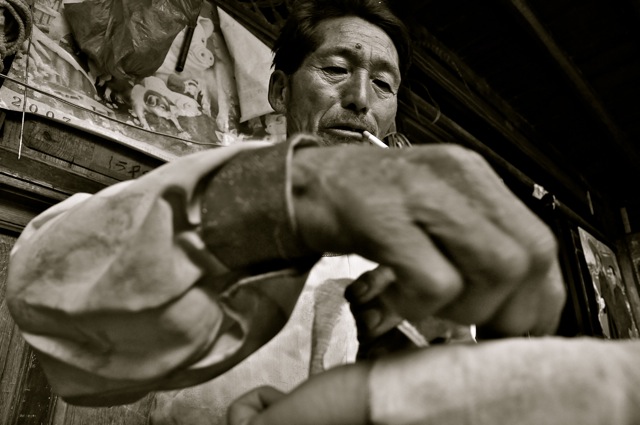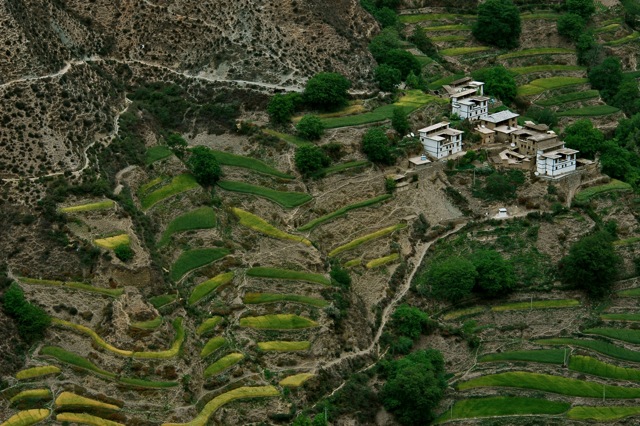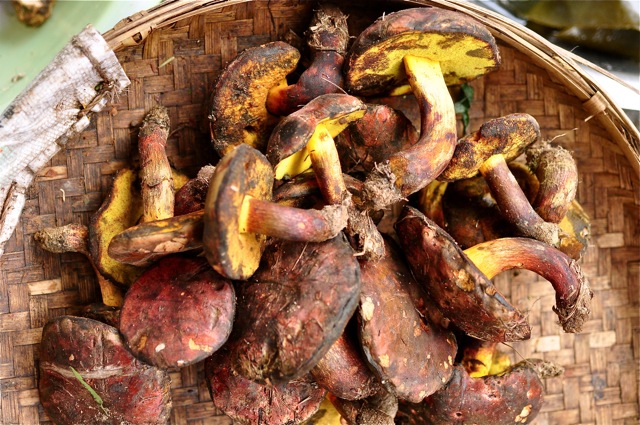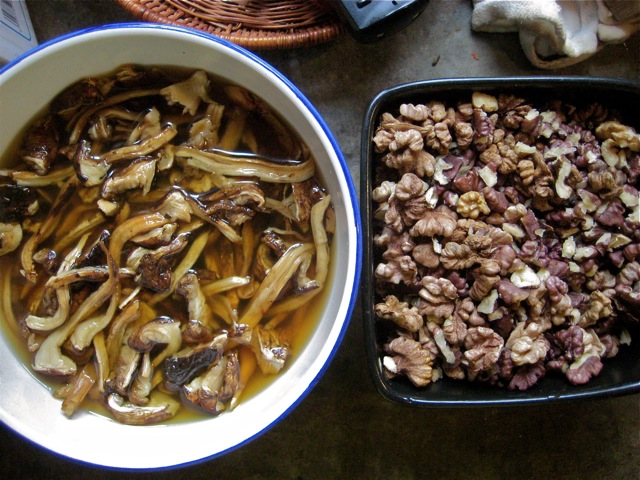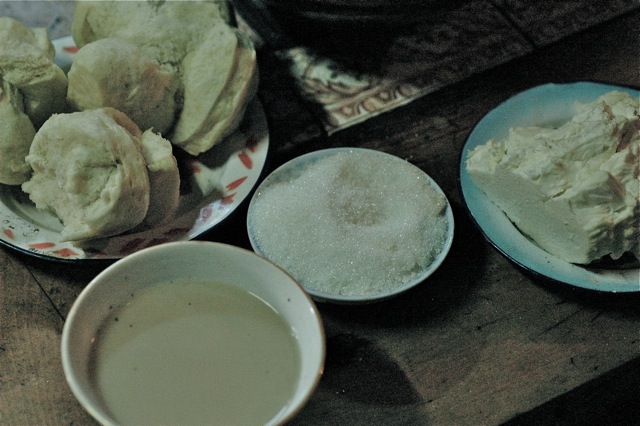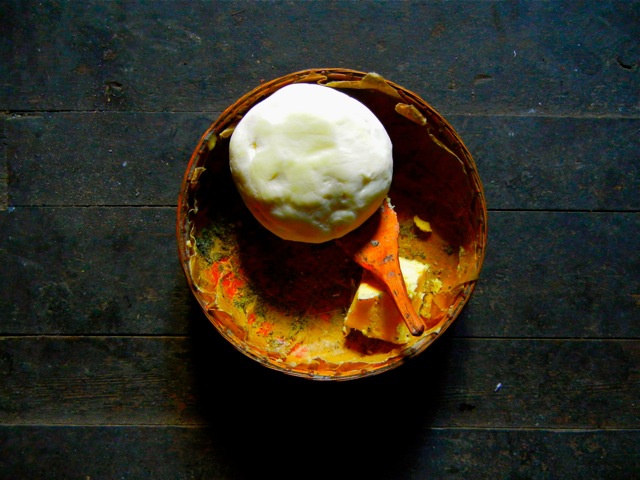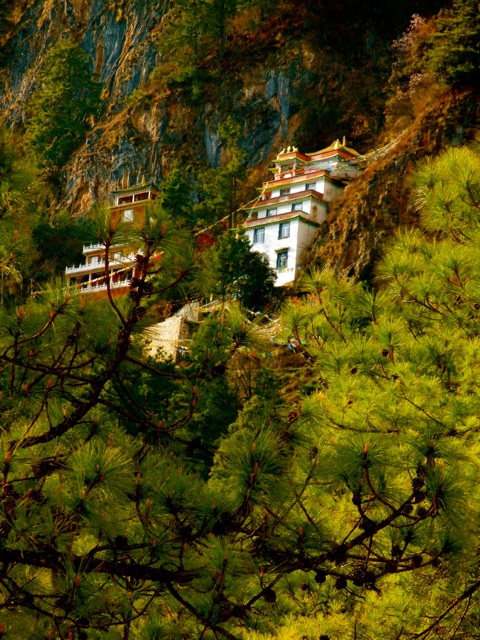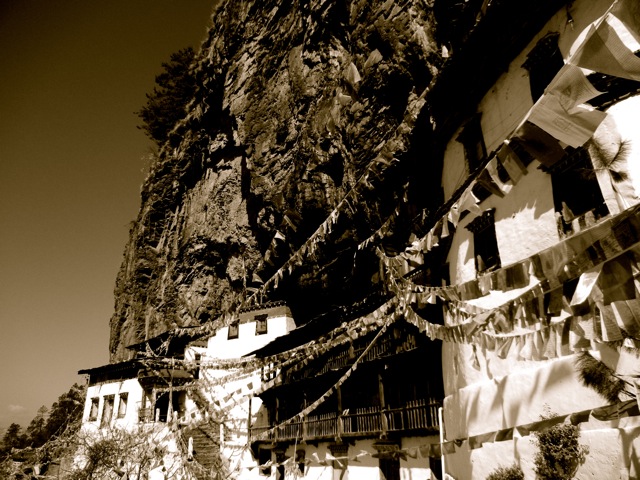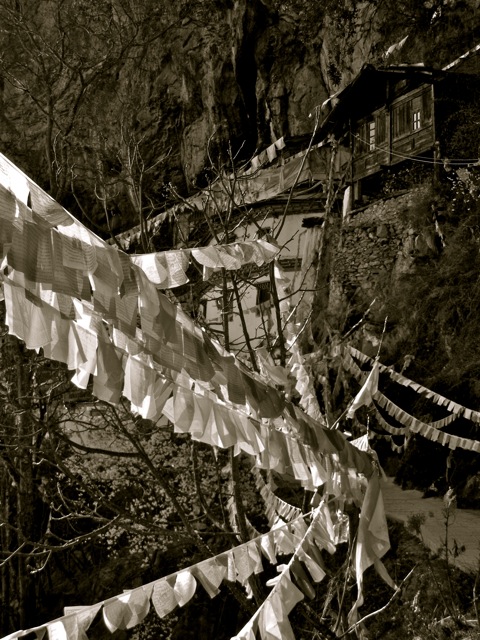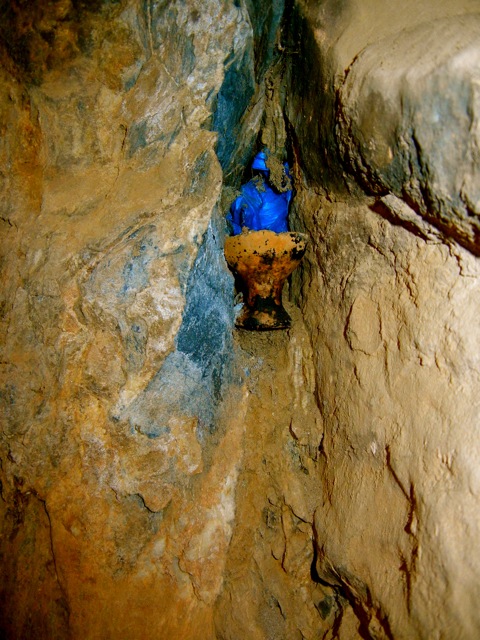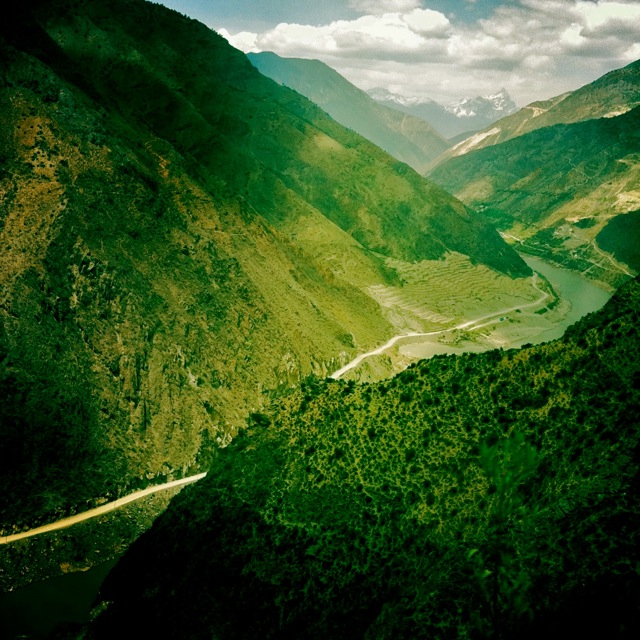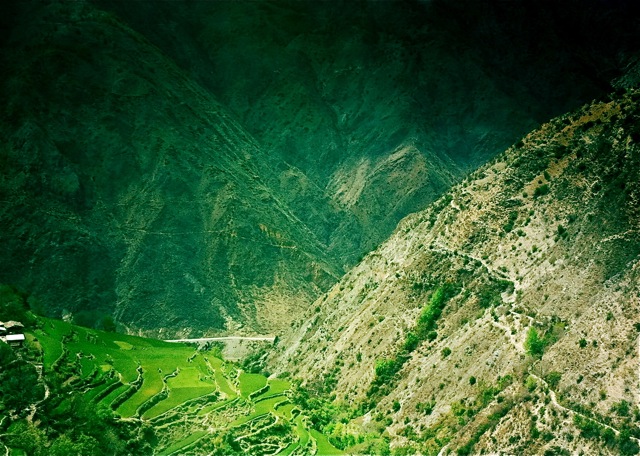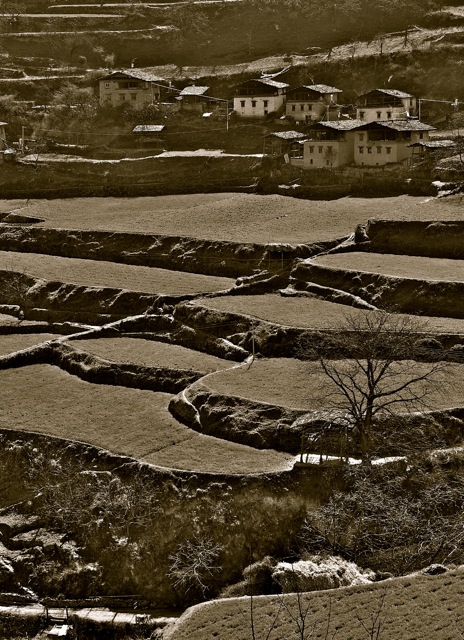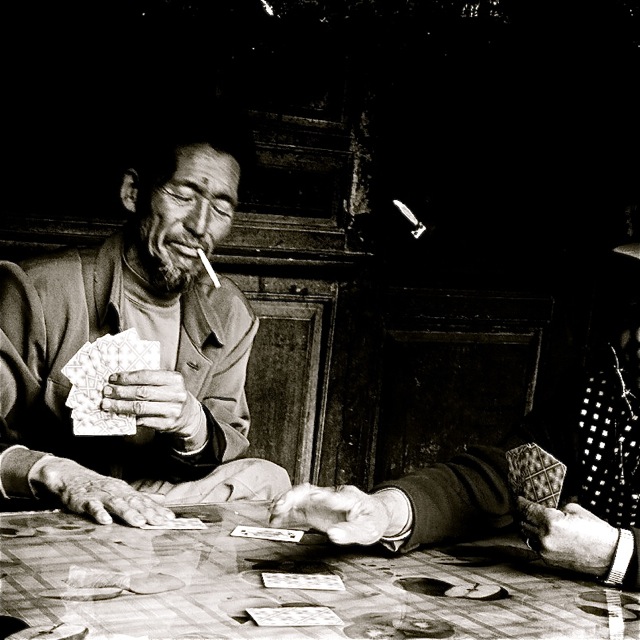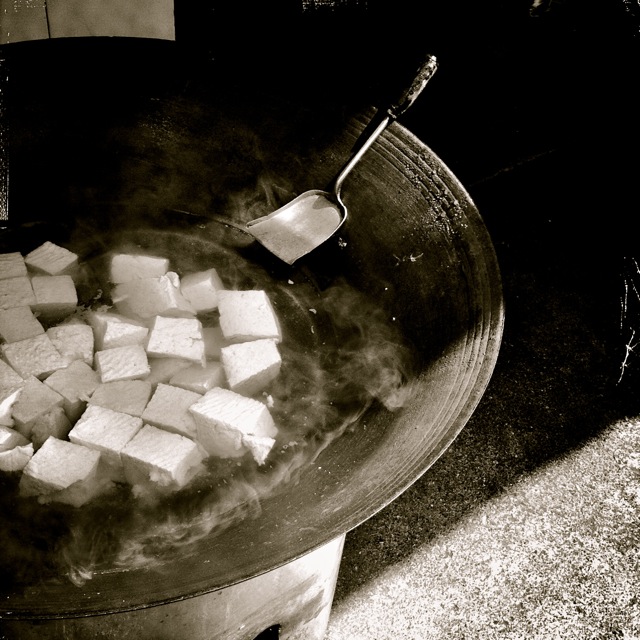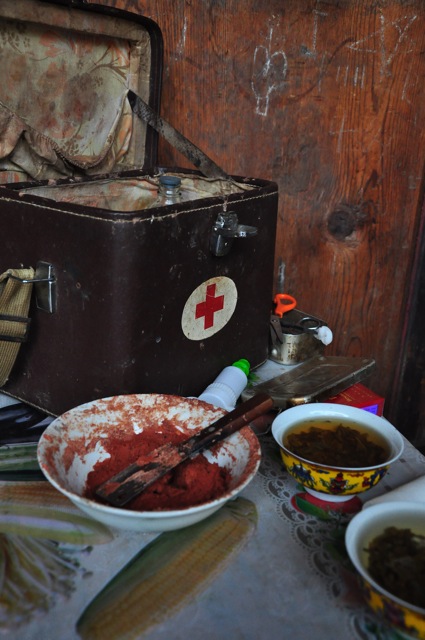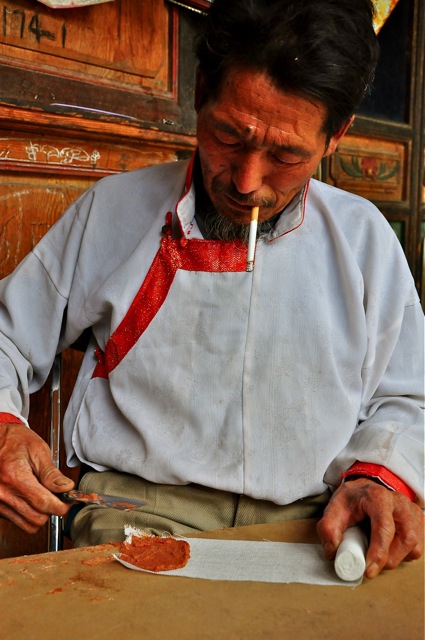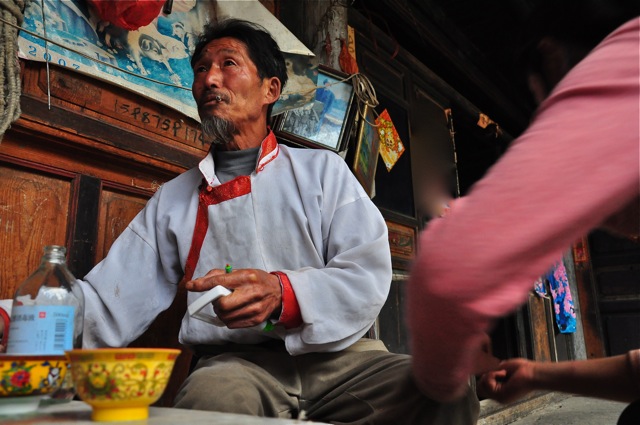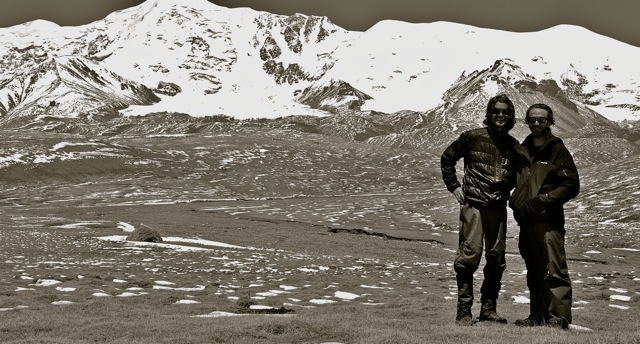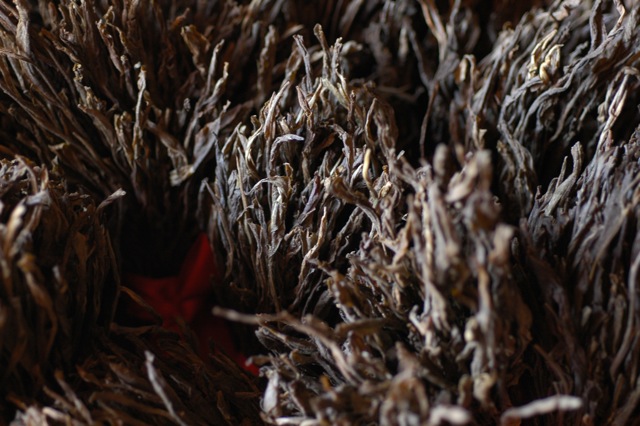The word for mist, clouds, and fog in many Tibetan regions is the same: mupa. Mupa is what engulfs us and sucks us all into itself and into a world of soft focused hues and biting wind. Rain slices in from the east – our destination lies east – cutting into us making the route slick and slippery. Every little stone body becomes little skid-pads of ice.
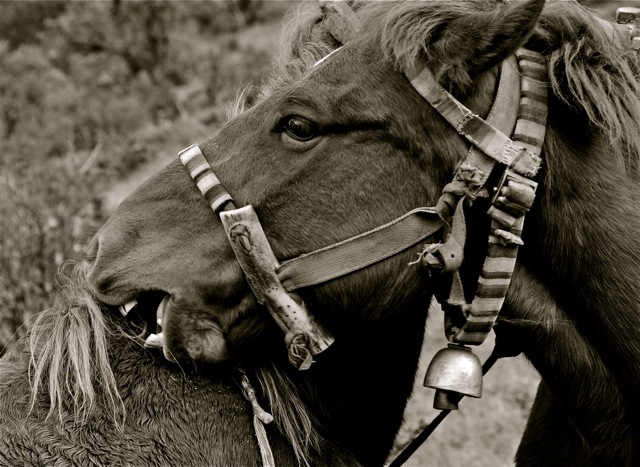
A little morning fun
Taking a high route that is slightly more precarious early on, we make high ground where we at least have the benefit of an extra metre or so of visibility. The fogs are running through valleys and holes like express trains obliterating everything. Our destination the lake, remains a complete and utter blank sheet. The students behind maintain a good pace, keeping words to a minimum for the first time on the journey. Footing is the only focus as the fogs have erased any vistas beyond a couple of metres…all eyes are on the stone-laden turf below each step. Mandates on such journeys are simple: amaze and challenge the senses, safe-keep bodies. My leading is broken by frequent looks over my shoulders to ensure my flock is intact and upright.
Our path is part yak trail, part ancient pilgrim route…flawless lines that follow contours that the eyes don’t always see. A dip in the path takes us into a pond basin, bound in by oblong stones. A voice oozing sarcasm cracks from behind asking if this is the lake. I know that it must be either Donnie or Hojip asking the question. It isn’t our lake. It is a collector pool for the larger lake above, the ‘mother lake’ but it is good to hear that humour is alive and well up here.
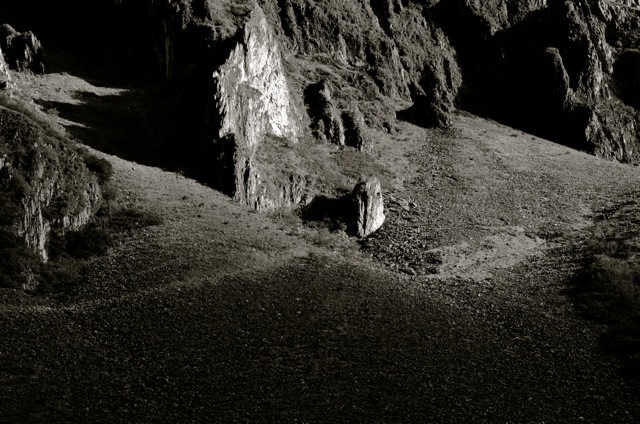
Yak and feel know well the true routes…and of course Songjè
Above us we hear unwieldy but welcome yelps of greetings so common in this northwestern frontier of Yunnan. Our horsemen are trudging gingerly along a high trail above us making their way back to camp, having paid their respects. There is Songjè leading once again, in that rough and elegant way of his. Hands raise in welcome but they too watch their steps carefully. Even the competent can lose their footing up here.
A little line marked with yak hoof prints – our path – dips down and then up. Suddenly prayer flags are right there in front of the eyes, all moist and sodden. Immediately behind their fluttering shapes is the grand expanse of the lake…which isn’t there. Hidden behind layers of mists only a vague outline of it remains. It is nothing but a slight darkening of tone. In a fire pit alongside the prayer flags – long used for pilgrims and worshipping fires – our horsemen’s discarded offering of juniper lies for some others to burn on a drier day. Damp rules the day and has infiltrated everything. Beside me, Markus, a silent, stoic student who trudges without a word or a sigh of complaint looks off into the space where the lake should be. He asks simply, “We will come tomorrow?”. I tell him we will and he simply nods.
Local lore has it that the lake itself is yak-shaped but for the students, this body of water and its shape will have to wait. Today, the fogs rule and no gusts will dissipate them.
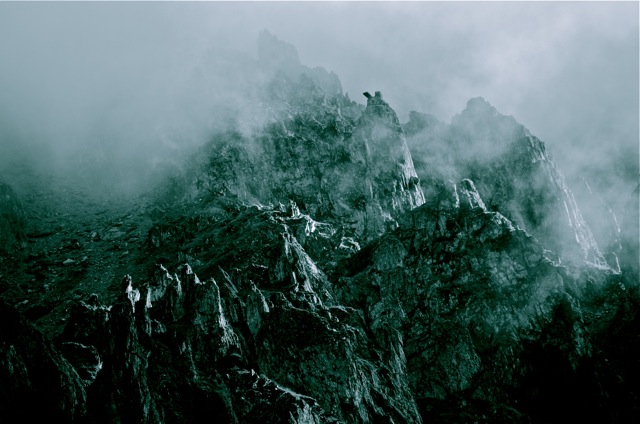
Mountains make no promises, nor do they keep them. Weather is up to elements and fates
Our sky then does something that Himalayan skies often do…it changes with no perceptible reason in an instant. It begins to clear bringing out pointed fingers and big eyes, gifting a view of a slightly changed lake that is bigger and somehow enhanced. We watch riveted and I hope that the valiant efforts of the group will see…
They don’t. The sky shuts our visual proceedings down quickly and as if wishing us away and sends a huge sheet of steely rain and wind down upon us and off we go. We’ve tasted but not sated and in some strange way our group is inspired rather than deflated. Tomorrow is another day and regardless of whatever else the students might feel they know their lungs and legs can make it (and just as crucially I now know they are up for it). There is always this gauging on such journeys of who is going to suffer but succeed, who is strong but cannot, and then in the more fascinating ‘middle’, those who come and for whatever reason seem to come out of a shell and ignite and find something more within themselves.
Our camp, and temporary shelter of coloured tents await us. Upon the ledge we will call home, the camp is empty as everyone has sought shelter inside their little homes. Ado the cook is the sole body at work making sure our hot fluid sustenance does indeed await us. Even the raw-boned horseman have tucked in under plastic sheets and thick wools. However grim the weather is, this is our little home and it is welcome.

Resin heavy Gün is an essential for any wanderings into the mountains
Tibetan camps are often little bits of brilliance if one takes the time to study them. Our fires are started and kept lit with one of the local specialties that come on every trip and are as valued as water itself. Gün is the local word for a species of resin-heavy pine which can light even when wet and as everything around is sodden, it is a joy to have two-inch long wedges and strips of the stuff in a satchel. As they are lit they give off that narcotic blend of primordial incense and wet-wood drug fragrance. Incense in Lhasa was also made from this resin delight and caravans would take loads of the stuff on their two-month journeys to the Himalayan capital.
Tibetan journeys through the mountains fascinate. Essentials for the elders and some of the mountain born and bred younger ones are simple: happy mules, butter, tea, windless nighttime abodes, fire and respect. Miss one of these elements and a mutiny will follow.
On a previous journey along this route another set of horsemen almost decided to return home after they balked at the route and the danger to their beloved mules. Slick slopes, a near plunge by two mules with their cargo and a few heated words resulted in a 10-minute period of reflection, calming words, and expletive or two and much shaking of the head before finally we could continue.
Later that evening I prod Songjè on one of my obsessive interests, the ancient caravan routes and his chocolate eyes widen in a kind of rapture as he mentions that those days were the days when travel was a “forever concept”.
That was a time when the seemingly immortal muleteers could be on the road half or more of every year and everything one owned could be packed on a horse and moved in 15 minutes. It was a time when one knew one’s needs he tells me.
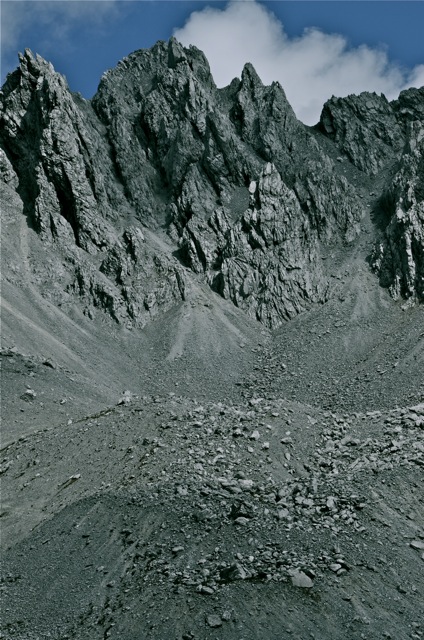
Vista above
Songjè sits cross legged eating an apple with his multiple layers wrapped snugly around his waist. Many of the elderly Tibetans believe that keeping the waist and organs of the lower back warm is a first priority, so while socks and footwear are often minimal even in leaden cold temperatures, the waist is usually contentedly wrapped.
The horsemen all sit facing the mountains staring up. Songjè then shakes his head and says to any who listen (and that is every single one of us who is near) that tomorrow’s weather will clear. Asking him how he knows would be useless but I’ve long learned to simply accept mountain men’s verdicts…on most things.
Max, who is Wild China’s calm and efficient ‘man to cover eventualities’ sits nursing his water studying the horseman. Max is part of our crew of necessaries and he fills in a multitude of rolls with a minimum of fuss. He has also informed me that this trip is one that continually fills and feeds him and I am content having him along as he ‘gets’ the experience for what it is.
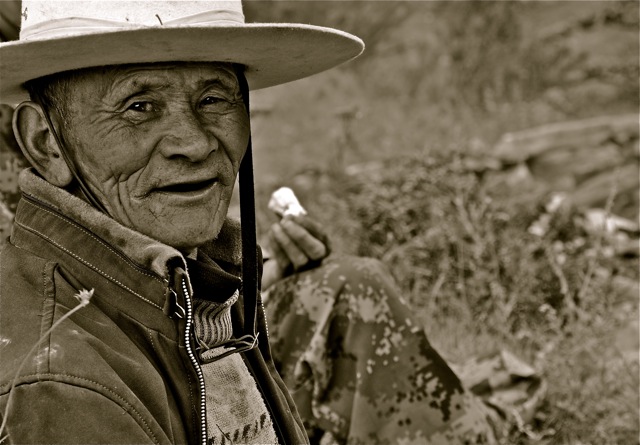
Though in his 70’s old our muleteer Tupten said that he preferred to be outside moving. He provided joy to the group and his tootless grin was one of my morning tonics
We are fortunate too to have Tashi Drolma, a local, whose broad female Tibetan smiles keep all in line and keep the young horseman eager to pleases. I note on the first night (and every night following) how no fewer than three horsemen erect her tent as they all figure out how to negotiate aluminum poles. In the end because of chatter and a bit of flirty banter, it takes them twice as long as it does for the students. This, like so many other little unwritten treats is what makes a journey something alive.
Dinner is a boisterous affair with rested students (and even those with thudding headaches) all coming to the dinner tent famished and in need of our nightly spark of socializing.
Nights in the mountains arrive without fanfare but they do arrive with impact. They drop dark blue night onto us with weight. With a warm dinner of rice, chicken soup, and spinach inside us all, bodies disappear into tents early and Mother Nature’s soundtrack takes over.
I have no doubts that Songjè’s little prophecy will prove certain regarding tomorrow’s weather. Arranging my tent against a small ridgeline I’ve made sure that the blasts of loong (wind) will not impede sleep. Some of the students have deliberately arranged their tents directly on the ridgeline to – in their words – “feel this wind thing.” Their energy and passion impress, and it will teach them what words will not.
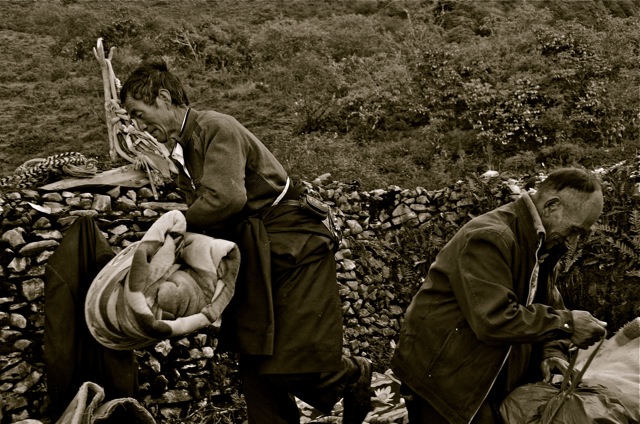
Even mighty Songjè must hustle into the morning freeze
——————–
The lower eye-lid can swell magnificently on a mountain morning given a bit of unfamiliar cold, frequent wake-ups, and general discomforts during the night. More than a few puffy eyes struggling for clarity emerge from the tents. Morning comes in still, but the night cold lies on surfaces, in the earth and upon the faces of many emerging students. Breakfast is silent but not sullen. By the end of eating, flush contentedness has replaced bulging eyes and tight skin.
Our lake awaits and for teenagers used to the comforts and joys of a modern existence they are already taking on toughened looks of competence. Young Aaron, who has a runner’s gazelle-like body has been chomped ragged by fleas and proudly displays the tell-tale red welts that circle both ankles and his waist. The fleas are products of the mules and for whatever reasons they seem to leave Aaron’s tent-mate’s flesh entirely alone. Once the voracious little brutes embed themselves in clothing, a sleeping bag, or a tent, they are generally there for the extent of the journey. Aaron’s little ‘friends’ will eat again.
Shannon, a powerful fearless young woman tells Aaron happily that the fleas are a gift, and I translate to old friend and trek partner Gelek. He looks at Shannon with a newfound respect and tells me that this is a very Buddhist way of looking at things.
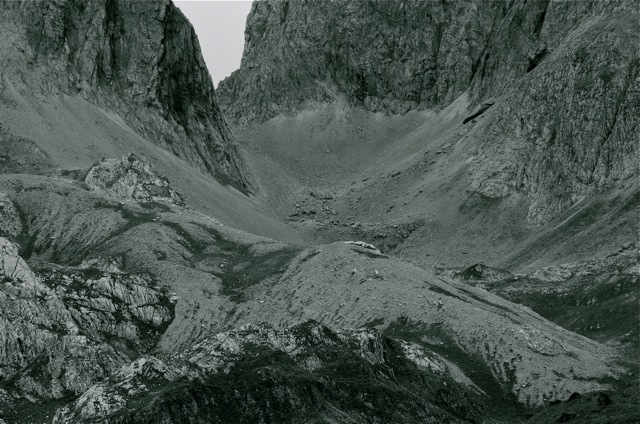
What rises above our camp
Our horsemen have already begun packing, though they too – even our resident titan Songjè – must shrug out of the morning cold which grips all moving bodies in a languid hug.
Skies above us turn from dull grey to cloud-heavy, leading to bolts of sunlight crushing everything in the matter of an hour. Our large group will split into two with competent Gelek leading one group and myself leading a group that will try and surge as high into the crater as we can.
The group’s energy is intent on wasting as little time as possible. The weather is already offering up landscapes that the night previous were but vague imaginings. With such offerings, we must move before the elements – as they do – decide to alter their settings.
What opens up, what slowly unveils, is the lake in perfect grey light. No need for rays of sunlight, no need for bolt-blue skies. The setting is enough on its own.
A crater filled with water that is pearl pure and a deepening blue green as its depth wanders down out of site into deep blue. Our journey here, almost identical to yesterdays, is a completely different ascent. Everything around us can be seen, whereas yesterday offered up only a bleak tunnel of nothing.
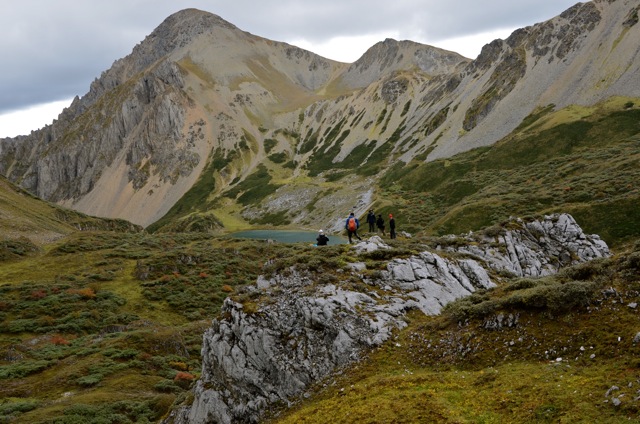
Our basin looking back at the lake
There are little sounds from our group and there is the wonderful silence of appreciation and my little mind glows that the space is ‘gotten’ (and visible).
Magic as it is to lay eyes upon the water beauty, the senses for me only really begin to tingle and hum up above…further away, further into nature’s great stone garden of heights.
At the lake our larger group breaks into two groups after a lakeside lunch. My group will ascend further up and the other will make a rough clockwise kora (circumambulation) around the sacred lake with Gelek and then wait for us down below.
We push on, weaving through rhododendrons which coil their powerful bodies close to the turf like guardians of the earth. Eventually though, they too give way until there are only shards of stone, and scree lining the walls of the giant basin that we move through.
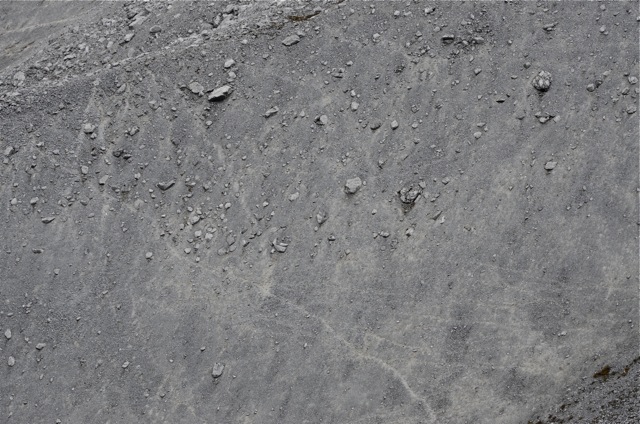
Striating, lethal, and mesmerizing, the pathways seem to defy gravity
There is joy amidst the temporary bouts of exhaustion for the students and our tiny unit at one point separates into pods to simply stand still and take it all in amidst heaving lungs and wide eyes.
William, a strong quiet student who seems to inhale portions of the view in between shooting photos, studies the scenes from left to right scanning the massive space around us. We are around 4,300 metres and it is a tribute that the students heads, hearts, and lungs have made it up here in a relatively short period.
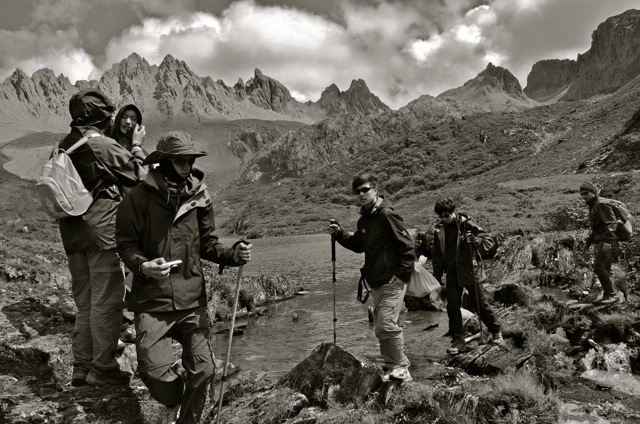
Our group comes over a lake outlet
I suddenly have this wish that Songjè was beside me taking this in, commenting on it and explaining parts of it. I know however that while my own pleasure principles at this altitude are engaged, many elder Tibetans do not view these sorties to sacred sites as playtime but rather something intense and something not to be tampered with. You arrive, pay respects and leave safely.
Suddenly sun pummels out of the sky, but the ominous beauty doesn’t get lost in the gold light. It simply becomes a larger vista.
We arrive an hour later to a trailhead where the other group waits for us on a shale slope. Our camp has been taken down and the colourful tent-life with it. The horsemen, and our elegant cook Ado, have already begun the journey to our next camp which rests in a grassland far below us. Of our recent camp only the stone foundations where the horsemen slept, and a gargantuan collection of fresh mule patties remain covering the bluff.
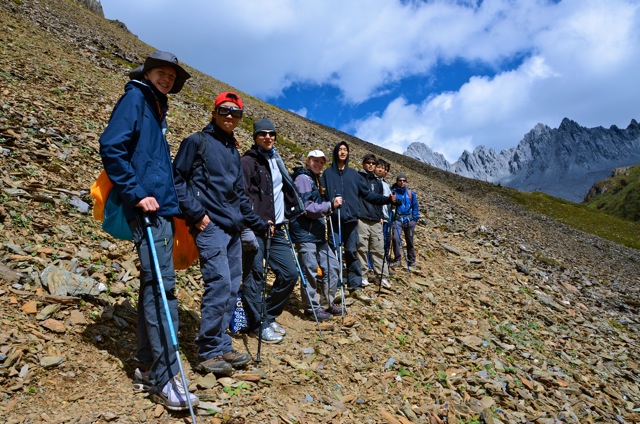
Some of the group pose for that very necessary ‘iconic shot’. Last but not least, Max, on the very far right maintains harmony
Making our way down ‘Aaron the Gazelle’ of the flea bites remarks that he is already missing the heights.
———-
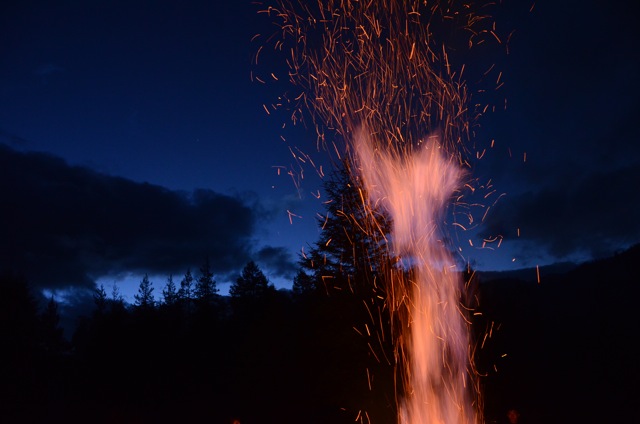
A purple fire blooms in the deep dusk as Songjè sings with an intense ferocity. As per everything he does on this journey, he renders the entire camp still with his songs to us, to the sky, and to the flames. An homage to all things near. He has danced, sung, danced again, and now he sings what will be his swan song on this journey.

Songjè in full cry
Our grassland camp is soft, lush, and green, but lacks the bite and intensity of higher up. It does however offer up a perfect natural pit for a bonfire of magnificent proportions.
Our last evening and the students sit around the fire, the horsemen sit close and only Ado our cook is absent. Even the mules seem to gather a bit closer.
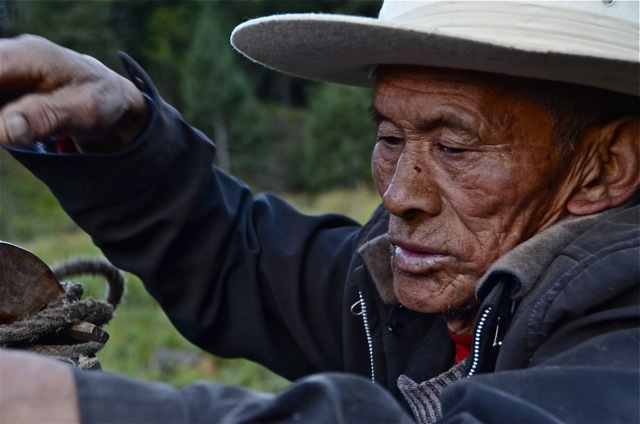
Before leaving camp for our departure back to walls and engines, a master prepares his mule
Songjè remarks to our group that on such an evening, good friends, new friends, food, drink , and fire are all that is needed. Altogether too briefly, he is entirely correct.
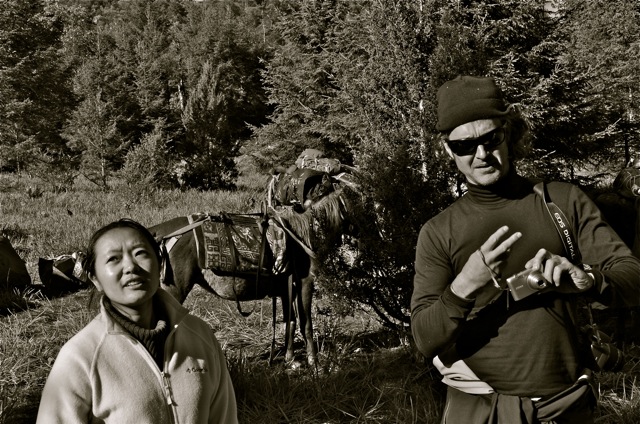
Tashi Drolma gazes at the mountains in farewell, while yours truly fiddles with 17 cameras for our farewell portraits
A local saying perhaps sums up best the remedy: “Journeys never really end.”
*Songjè and I conspire (as I write) to depart on another journey.

